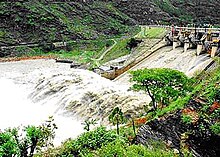Pandoh Dam
| Pandoh Dam | |
|---|---|
 |
|
|
Location of Pandoh Dam in India
|
|
| Country | India |
| Location | Mandi district |
| Coordinates | 31°40′17″N 77°04′01″E / 31.67139°N 77.06694°ECoordinates: 31°40′17″N 77°04′01″E / 31.67139°N 77.06694°E |
| Status | Operational |
| Opening date | 1977 |
| Owner(s) | Beas Construction Board |
| Dam and spillways | |
| Type of dam | Embankment |
| Impounds | Beas River |
| Height | 76 m (249 ft) |
| Length | 255 m (837 ft) |
| Dam volume | 1,580,000 m3 (2,066,562 cu yd) |
| Spillway capacity | 9,939 m3/s (350,992 cu ft/s) |
| Reservoir | |
| Creates | Pandoh Lake |
| Total capacity | 41,000,000 m3 (33,239 acre·ft) |
| Surface area | 1.7 km2 (1 sq mi) |
| Power station | |
| Name | Dehar Power Plant |
| Coordinates | 31°24′37″N 76°51′43″E / 31.41018°N 76.86205°E |
| Commission date | 1977 |
| Hydraulic head | 335 m (1,099 ft) |
| Turbines | 6 x 165 MW (221,000 hp) Francis-type |
| Installed capacity | 990 MW (1,330,000 hp) |
The Pandoh Dam is an embankment dam on the Beas River in Mandi district of Himachal Pradesh, India. Under the Beas Project, the dam was completed in 1977 and its primary purpose is hydroelectric power generation. Part of a run-of-the-river power scheme, it diverts the waters of the Beas to the southwest through a 38 km (24 mi) long system of tunnels and channels. The water is used for power generation at the Dehar Power House before being discharged into the Sutlej River, connecting both rivers. The power house has an installed capacity of 990 MW. The system diverts 256 cumecs (9000 cusecs) of Beas waters to the Satluj River. The project was completed in 1977.
The two major rivers Beas and Satluj flow out of the himalayas and reach a point where they are separated by a crow fly distance of approximately 36 km and have an elevation difference of approximately 1099 ft. The waters of Beas are continuous flow from ice-melt and flow throughout the year. This was realized and a plan made to exploit the potential of this river system. The power potential was estimated as 1,000 MW. The plans originally called Beas Project Unit - I Beas Satluj Link Project went through several revisions for diverting the waters of Beas river. The first plan prepared by Punjab Irrigation Department in 1957. The 1957 plan contemplated a diversion dam at Pandoh, 11.26-kilometre (7.00 mi) tunnel, 19.31-kilometre (12.00 mi) open channel, 4.82-kilometre (3.00 mi) tunnel. The 1957 report was followed by a 1960 report and the final proposal in 1961. The final proposal included 76.25-metre (250.2 ft) diversion dam at Pandoh, a 7.62-metre (25.0 ft) dia, 13.11-kilometre (8.15 mi) Pandoh baggi tunnel, 11.8-kilometre (7.3 mi) Sunder Nagar hydel channel, 8.53-metre (28.0 ft) dia, 12.35-kilometre (7.67 mi) Sundernagar Satluj tunnel, 22.86-metre (75.0 ft) dia 125-metre (410 ft) high surge shaft, three Dehar penstocks split to six penstocks and Dehar power plant with 6 x 165 MW generators. The system would divert 9,000 cubic feet per second (250 m3/s) of the Beas to the Satluj. An added benefit of the project was the increased inflow to Gobind Sagar thereby increasing power generation capacity at Bhakra Dam and added irrigation waters for the states of Punjab and Haryana. The project was approved in 1963 and commissioned in 1977.
...
Wikipedia

